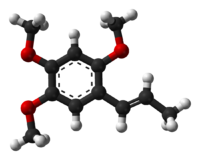- Asarone
-
α-Asarone 
 1,2,4-Trimethoxy-5-[(E)-prop-1-enyl]benzeneOther namesalpha-Azaron
1,2,4-Trimethoxy-5-[(E)-prop-1-enyl]benzeneOther namesalpha-Azaron
cis-Isoelemicin
2,4,5-Trimethoxyphenyl-2-propeneIdentifiers CAS number 2883-98-9 
PubChem 636822 ChemSpider 552532 
ChEMBL CHEMBL333306 
Jmol-3D images Image 1
Image 2- CC=CC1=CC(=C(C=C1OC)OC)OC
O(c1cc(c(OC)cc1OC)/C=C/C)C
Properties Molecular formula C12H16O3 Molar mass 208.254 g mol−1 Appearance colorless solid substance Density 1.028 g/cm−3 [1] Melting point 62-63 °C [2]
Boiling point 296 °C [2]
Solubility in water insoluble  (verify) (what is:
(verify) (what is:  /
/ ?)
?)
Except where noted otherwise, data are given for materials in their standard state (at 25 °C, 100 kPa)Infobox references Asarone, which includes alpha (trans) and beta[3] (cis) types, is an ether found in certain plants such as acorus and asarum.[2] As a volatile fragrance oil, it is used in killing plant fungal[4] pests and bacteria.[5] The toxicity and carcinogenicity of asarone means that it may be difficult to develop practical anthelmintics and insecticides based on it.[6]
Pharmacology
The main clinical symptom of asarone is prolonged vomiting that sometimes lasted more than 15 hours. Asarone is not metabolized to trimethoxyamphetamine as has been claimed by online vendors.[7]
See also
Notes and references
- ^ Data for α-Asarone at ChemSpider
- ^ a b c "Asarone". The Merck Index. 14th edition. Merck Research Laboratories. 2006. pp. 135. ISBN 978-0-911910-00-1.
- ^ Beta asarone has CAS# 5273-86-9
- ^ Suvarna Shenvi, Vinod, Rajendra Hegde, Anil Kush and G. Chandrasekara Reddy (2011). "A unique water soluble formulation of β-asarone from sweet flag (Acorus calamus L.) and its in vitro activity against some fungal plant pathogens". Journal of Medicinal Plants Research 5 (20): 5132–5137. http://www.academicjournals.org/JMPR/PDF/pdf2011/30Sept/Shenvi%20et%20al.pdf.
- ^ Asha DS, Ganjewala D (2009). "Antimicrobial activity of Acorus calamus (L.) rhizome and leaf extract". Act. Biol. Szeg. 53 (1): 45–49.
- ^ Perrett, Sheena; Whitfield, Philip J. (1995). "Anthelmintic and pesticidal activity ofAcorus gramineus (Araceae) is associated with phenylpropanoid asarones". Phytotherapy Research 9 (6): 405. doi:10.1002/ptr.2650090604.
- ^ Björnstad K, Helander A, Hultén P, Beck O (2009). "Bioanalytical investigation of asarone in connection with Acorus calamus oil intoxications". J Anal Toxicol 33 (9): 604–9. PMID 20040135.

This article about an organic compound is a stub. You can help Wikipedia by expanding it. - CC=CC1=CC(=C(C=C1OC)OC)OC
